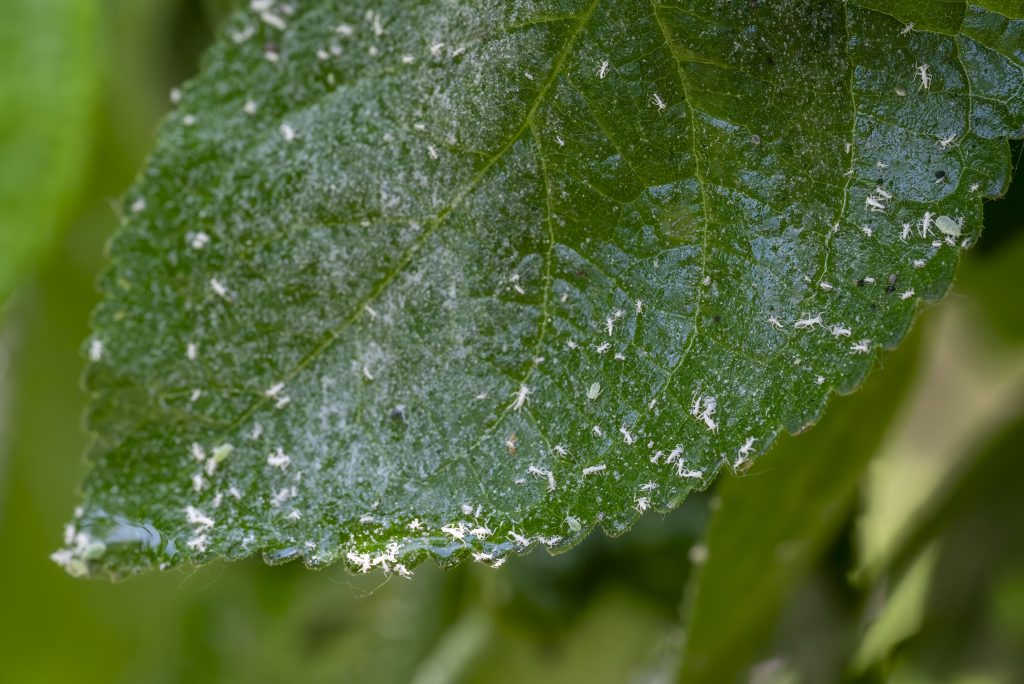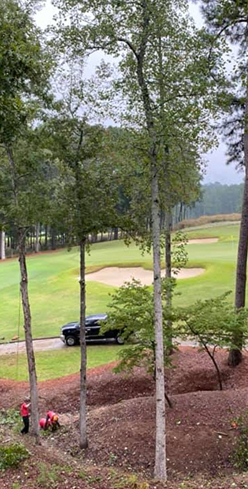White flies are a common pest that can harm your plants. If you’re looking for how to get rid of white flies on plants, this guide offers effective ways to identify, prevent, and eliminate these pests to keep your plants healthy.
Identifying White Flies
The first step in combating a whitefly infestation is accurate identification. White flies are common pests that affect a wide variety of plants, causing significant damage if left uncontrolled. These pests are tiny and are often found on the undersides of leaves, making them somewhat elusive at first glance.
When disturbed, swarms of these tiny insects will fly off the plant, which is a clear indication of their presence. White flies have yellowish bodies and four whitish wings, with a white, waxy material covering both their bodies and wings. The greenhouse whitefly is a species commonly found indoors and is notorious for spreading rapidly. White flys are often mistaken for other pests due to their small size.
Physical Characteristics
Adult whiteflies typically measure between 1-2 mm in length and have a triangular shape with vertical wings resting over their bodies. They usually exhibit a white or pale yellow coloration due to the waxy powder that covers their bodies and wings, making them relatively easy to spot if you know where to look.
Signs of Infestation
One of the telltale signs of a whitefly breakout is the presence of black sooty mold on leaves, which grows on the honeydew excreted by these insects. Infested plants may also exhibit yellowing leaves as whiteflies extract plant sap from the foliage, leading to significant plant stress and reduced vigor. This honeydew not only attracts fungal diseases but also other pests that can exacerbate the problem.
Regular inspection of the undersides of a single leaf is crucial for identifying and managing whiteflies. Early detection allows for quicker implementation of control measures, preventing a severe infestation.
White Fly Life Cycle
Understanding the life cycle of whiteflies is essential for effective management. Whiteflies undergo six distinct stages in their development: egg, four larval instars, and adult.
The complete life cycle typically lasts from 2 1/2 to 5 weeks, allowing for rapid population growth under favorable conditions.
Egg Stage
Female whiteflies lay their eggs on the underside of leaves in a circular pattern. These eggs are often laid in large numbers, making early detection and control crucial to prevent a full-blown infestation of a single female whitefly.
Nymph Stage
Once the eggs hatch, the nymphs start to crawl around. They do this until they locate a suitable spot to lay eggs. Once settled, they become immobile and begin sucking plant juices from the underside of leaves, causing significant damage to the host plant.
Adult Stage
Adult whiteflies reside primarily on the undersides of leaves where they lay new eggs, perpetuating the infestation cycle. These adults are responsible for most of the visible damage to plants, and their rapid reproduction can lead to severe infestations in a short period.
Effective Prevention Methods
Prevention is always better than cure, especially when it comes to whiteflies. Maintaining a clean yard and healthy plants is a crucial preventative measure to prevent these pests from establishing large populations.
Reflective mulch can also deter whiteflies by repelling them from vegetable gardens, adding another layer of protection.
Healthy Plants
Healthy plants exhibit greater resilience against pests. They are also better equipped to withstand diseases. Regular watering and maintaining proper soil moisture levels can deter whiteflies and support plant health. Avoiding high-nitrogen fertilizers is also important, as these attract pests by encouraging rapid new growth.
Quarantining new plants for 2 to 3 weeks before introducing them to your garden can prevent the transfer of pests to other plants. Reflective mulches not only enhance crop growth but also repel whiteflies and other pests, making them an excellent investment for any gardener, especially for those with various plants grown.
Inspect New Plants
Inspecting new plants for signs of whiteflies and other pests is a critical step in preventing infestations. Always check the undersides of plant leaves for eggs and nymphs, and consider keeping new plants isolated until you are sure they are pest-free.
Regular Monitoring
Regular monitoring and early intervention are key to keeping ornamental plants like hibiscus and roses free from whiteflies and their host plants.
Using a handheld vacuum in the cooler early morning temperatures can efficiently collect whiteflies before they become active.
Natural Remedies to Get Rid of White Flies
Natural remedies are often the preferred choice for managing whitefly infestations due to their safety and environmental benefits.
Here are some effective methods:
- Water sprays can dislodge whiteflies.
- Horticultural oils can suffocate their eggs and nymphs.
- Certain plant varieties, such as catnip and bee balm, act as natural repellents.
Additionally, predatory insects like lacewings and minute pirate bugs can help control whiteflies.
Neem Oil Sprays
Neem oil is a highly effective natural remedy for whiteflies. It acts as a repellent, reducing the impact on plants and disrupting the feeding and reproductive processes of whiteflies.
Sticky Traps
Yellow sticky traps are an effective tool for capturing giant whiteflies. These traps should be placed near infested leaves and positioned facing the plants but away from direct sunlight to maximize their effectiveness. You should place yellow sticky traps with the sticky side facing the plants to efficiently capture the flying insects.
Cleaning the traps regularly is essential to maintain their efficacy and ensure they continue to capture whiteflies effectively. Homemade sticky traps can be created using a sticky substance like petroleum jelly, offering a cost-effective solution for managing whitefly populations.
Insecticidal Soap
Insecticidal soap and liquid dish soap is a natural method for controlling whiteflies on plants. A soapy water mix can effectively eliminate whiteflies while ensuring plant health. Make sure the soap mixture is safe for plants and used as per instructions to prevent any damage.
Using insecticidal soaps as part of a regular pest control routine can help manage whitefly populations without resorting to harsh pesticides. A spray bottle can be an effective tool for applying these soaps.
Biological Controls
Biological controls involve using natural predators to manage whitefly breakouts. Whiteflies have natural predators in many species of songbirds and hummingbirds. These birds often feed on whiteflies, helping to control their population.
Additionally, planting varieties that attract these birds or investing in bird feeders, birdhouses, or birdbaths can make your yard more hospitable to these insects.
Parasitic Wasps
Encarsia formosa is a specific wasp known for effectively controlling whitefly infestations, particularly in greenhouse settings. These wasps target whitefly eggs, significantly reducing their populations.
Predatory Insects
Natural predators like lacewings, big-eyed bugs, minute pirate bugs, and lady beetles are highly effective at managing whitefly populations. Ladybugs, in particular, are well-known for their ability to control aphids and whiteflies, making them a valuable addition to any garden.
Encouraging these beneficial insects and their natural enemies in your garden can significantly reduce the need for chemical interventions and promote a healthier ecosystem.
Mechanical Control Methods
Mechanical control methods provide effective physical techniques to reduce whitefly populations in a safe manner. These methods include vacuuming and pruning infested leaves, which can be highly effective when used in conjunction with other control strategies.
Vacuuming
Vacuuming is an effective method for removing adult whiteflies from plants. The best time to vacuum is early in the morning when the whiteflies are less active, making them easier to capture.
After vacuuming, dispose of the vacuum bag in an outdoor trash bin to prevent any return of the pests.
Pruning Infested Leaves
Pruning infested leaves is a straightforward yet highly effective method for controlling whitefly populations. By cutting away heavily infested leaves, you can significantly lower the number of whiteflies and prevent them from spreading to healthier parts of the plant. This method is especially useful for managing infestations in smaller gardens or indoor plants.
In cases of severe infestations, it may be necessary to remove and destroy the entire host plant to prevent the whiteflies from spreading to adjacent plants. Regular pruning and disposal of infested plant material can help maintain a healthy garden environment and reduce the likelihood of recurring whitefly problems.
Chemical Control Options
When natural and mechanical methods fail to control whitefly populations effectively, chemical control options may be necessary. These treatments should be considered as a last resort and used responsibly to minimize their impact on beneficial insects and the overall ecosystem.
Horticultural Oils
Horticultural oils, including neem oil, are less-toxic products that can be effective against whiteflies. These oils work by smothering whitefly eggs and nymphs, thereby reducing their population on affected plants. Neem oil sprays, in particular, are a popular choice due to their effectiveness and minimal impact on the environment.
Using horticultural oils as part of an integrated pest management strategy can provide an effective and environmentally-friendly method for controlling whitefly infestations. These oils are suitable for use on a wide variety of plants, including indoor plants, ornamental plants, and food crops.
Chemical Pesticides
Chemical pesticides should be used as a last resort for severe whitefly attacks. These pesticides can have significant implications on beneficial insects and the overall health of the ecosystem, so it’s important to prioritize other whitefly management methods such as prevention, natural remedies, or biological controls before resorting to chemicals.
When using pesticides, it’s crucial to follow the manufacturers instructions carefully and apply them only to the affected areas. This targeted approach can help minimize the impact on non-target species and reduce the risk of developing pesticide-resistant whiteflies.
Frequently Asked Questions
What are the first signs of a whitefly infestation?
The first signs of a whitefly infestation are yellowing leaves, black sooty mold, and the presence of tiny white insects that swarm when the plant is disturbed. It’s essential to address these symptoms promptly to protect your plants.
How can I naturally get rid of whiteflies on my plants?
To effectively eliminate whiteflies, consider using neem oil sprays, yellow sticky traps, and insecticidal soap. Additionally, introducing positive insects such as lacewings and ladybugs can provide natural control of these pests.
What is the role of parasitic wasps in controlling whitefly infestations?
Parasitic wasps, especially Encarsia formosa, play a crucial role in controlling whitefly infestations by parasitizing whitefly eggs, which significantly diminishes their populations. This natural method of pest control can effectively reduce reliance on chemical pesticides.
When should I consider using chemical pesticides for whitefly control?
Consider using chemical pesticides for whitefly control only when natural and mechanical methods fail to effectively manage severe infestations. Responsible application is crucial to protect beneficial insects and the ecosystem.
How can Arbor Equity help with my whitefly problem and keep my plants healthy?
Arbor Equity can effectively address your whitefly problem by providing tailored treatments that utilize both natural and chemical control methods. Their expert team will assess your specific situation and implement a management plan to eliminate the infestation.
How Arbor Equity Can Help Battle White Flies on Plants
Arbor Equity offers professional tree services in Georgia, including treatments for white flies. Our expert team can help identify and manage whitefly infestations on your plants, ensuring they remain healthy and vibrant. We utilize a combination of natural and chemical control methods tailored to your specific needs, helping to effectively reduce whitefly populations and prevent future infestations.
If you’re struggling with a whitefly problem or need advice on maintaining healthy plants, contact Arbor Equity today. Our comprehensive pest control services can help you get rid of whiteflies and keep your garden thriving.
Don’t let whiteflies ruin your plants! Let Arbor Equity be your trusted partner in plant care and pest management.



